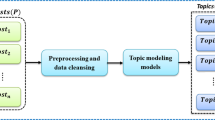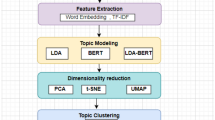Abstract
In this paper, we pay attention to reveal the event topics and track the evolutionary trend of social event and a novel probabilistic topic model is proposed. The Multi-modal Multi-layered Topic Classification Model (tm_MMC) for Social Event Analysis has the capacity for revealing visual and non-visual topics, by jointly modeling the textual and visual information while simultaneously learning and predicting the multi-layered category labels. In order to track the evolutionary trends of the topics online, tm_MMC uses topic intensity and heritability to incrementally build an up-to-date model. To evaluate the effectiveness of our model, we experiment using a collected data, and compare the results with those of other traditional models. The results demonstrate the effectiveness and advantages of our model against several state-of-the-art methods.






Similar content being viewed by others
References
Achanta R, Shaji A, Smith K, Lucchi A, Fua P, Susstrunk S (2010) Slicsuperpixels. Tech. Rep, EPFL
Adams RP, Ghahramani Z, Jordan MI (2010) Tree-structured stick breaking for hierarchical data. NIPS, pp 19–27
Allan J (2002) Topic detection and tracking: Event-based information organization. Kluwer Academic Publishers, Boston
Antoniak CE (1974) Mixtures of dirichlet processes with applications to bayesian nonparametric problems. Ann Stat 2(6):1152–1174
Bao Y, Collier N, Datta A (2013) A partially supervised cross-collection topic model for cross-domain text classification. ACM international conference on information and knowledge management, pp 239–248
Barnard K, Duygulu P, Forsyth D, De Freitas N, Blei DM, Jordan MI (2003) Matching words and pictures. J Mach Learn Res 3(2):1107–1135
Becker H, Naaman M, Gravano L (2009) Event identification in social media. WebDB, pp 291–300
Blei DM, Jordan MI (2003) Modeling annotated data. International ACM SIGIR conference on research and development in information retrieval, pp 127–134
Blei DM, Mcauliffe JD (2010) Supervised topic models. Advances in Neural Information Processing Systems 3:327–332
Blei DM, Ng AY, Jordan MI (2003) Latent dirichlet allocation. J Mach Learn Res 3:993–1022
Diakopoulos N, Naaman M, Kivran-Swaine F (2010) Diamonds in the rough: Social media visual analytics for journalistic inquiry. Visual analytics science and technology, pp 115–122
Escalante HJ, Sucar LE, Montes M (2008) Late fusion of heterogeneous methods for multimedia image retrieval. ACM international conference on multimedia information retrieval, pp 172–179
Gao H, Tang S, Zhang Y, Jiang D, Wu F, Zhuang Y (2012) Supervised Cross-collection Topic Modeling. ACM multimedia, pp 957–960
Hatzivassiloglou V, Gravano L, Maganti A (2000) An investigation of linguistic features and clustering algorithms for topical document clustering, pp 224–231
Hoffman MD, Blei DM, Bach FR (2010) Online learning for latent dirichlet allocation. Advances in neural information processing systems 23:856–864
Kim JH, Kim D, Kim S, Oh A (2012) Modeling topic hierarchies with the recursive Chinese restaurant process. ACM international conference on information and knowledge management, pp 783–792
Kliegr T, Chandramouli K, Nemrava J, Svatek V, Izquierdo E (2008) Combining image captions and visual analysis for image concept classification. International Workshop on Multimedia Data Mining: Held in Conjunction with the ACM SIGKDD 29:10–16
Lacoste-Julien S, Sha F, Jordan MI (2008) Disclda: discriminative learning for dimensionality reduction and classification. Proceedings of NIPS neural information processing systems, pp 897–904
Li C, Sun A, Datta A (2012) Twevent: segment-based event detection from tweets. ACM international conference on information and knowledge management, pp 155–164
Li LJ, Socher R, Li FF (2009) Towards total scene understanding: classification, annotation and segmentation in an automatic framework. IEEE conference on computer vision and pattern recognition, pp 2036–2043
Lin YR, Sundaram H, De Choudhury M, Kelliher A (2012) Discovering multirelational structure in social media streams. ACM Transactions on Multimedia Computing Communications and Applications 8(1):4
Liu X, Huet B (2013) Heterogeneous features and model selection for Event-Based media classification. ACM international conference on multimedia retrieval, pp 151–158
Makkonen J, Ahonen-Myka H, Salmenkivi M (2004) Simple semantics in topic detection and tracking. Information Retrieval Journal 7(3):347–368
Mcminn AJ, Moshfeghi Y, Jose JM (2013) Building a large-scale corpus for evaluating event detection on twitter. ACM international conference on information and knowledge management, pp 409–418
Minka TP (2003) Estimating a Dirichlet distribution. In UAI-2002 39(3273):115
Nguyen CT, Zhan DC, Zhou ZH (2013) Multi-modal image annotation with Multi-instance Multi-label LDA. International joint conference on artificial intelligence, pp 1558–1564
Niu Z, Hua G, Gao X, Tian Q (2011) Spatial-discLDA for visual recognition. Comput Vis Pattern Recognit 42:1769–1776
Patel D, Hsu W, Lee ML (2008) Mining relationships among interval-based events for classi-fication. ACM SIGMOD international conference on management of data, pp 393–404. DBLP
Pham TT, Maillot NE, Lim JH, Chevallet JP (2007) Latent semantic fusion model for image retrieval and annotation. 16th ACM conference on information and knowledge management, pp 439–444
Putthividhy D, Attias HT, Nagarajan SS (2010) Topic regression multi-modal Latent Dirichlet Allocation for image annotation. Comput Vis Pattern Recognit 238:3408–3415
Qian S, Zhang T, Xu C (2014) Multi-modal supervised latent dirichlet allocation for event classification in social media, pp 152–157
Radinsky K, Horvitz E (2013) Mining the web to predict future events. ACM international conference on web search and data mining, pp 255–264
Ramage D, Hall D, Nallapati R, Manning CD (2009) Labeled LDA: a supervised topic model for credit attribution in multi-labeled corpora. Conference on Empirical Methods in Natural Language Processing 1:248–256
Reuter T, Cimiano P (2012) Event-based classification of social media streams. ACM international conference on multimedia retrieval, pp 22–30
Sang J, Xu C (2012) Right buddy makes the difference: an early exploration of social relation analysis in multimedia applications. ACM multimedia, pp 19–28
Suhara Y, Toda H, Sakurai A (2008) Extracting related named entities from blogosphere for event mining. International conference on ubiquitous information management and communication, pp 225–229
Teh YW, Jordan MI, Beal MJ, Blei DM (2006) Hierarchical dirichlet processes. J Am Stat Assoc 101(476):1566–1581
Wang X, Mccallum A (2006) Topics over time: a non-Markov continuous-time model of topical trends. 12th ACM SIGKDD international conference on knowledge discovery and data mining, pp 424–433
Wang Y, Mori G (2009) Human action recognition by semilatent topic models. IEEE Transactions on Pattern Analysis and Machine Intelligence 31(10):1762
Wang C, Blei D, Li FF (2009) Simultaneous image classification and annotation. IEEE conference on computer vision and pattern recognition, pp 1903–1910
Wang G, Hoiem D, Forsyth D (2009) Building text features for object image classification. IEEE computer society conference on computer vision and pattern recognition, pp 1367–1374
Yang X, Zhang T, Xu C, Hossain MS (2015) Automatic visual concept learning for social event understanding. IEEE Transactions on Multimedia 17(3):346–358
Zhang T, Xu C (2014) Cross-domain multi-event tracking via copmht. Acm Transactions on Multimedia Computing Communications and Applications 10(4):1–19
Zhang K, Zi J, Wu LG (2007) New event detection based on indexing-tree and named entity. SIGIR 2007: Proceedings of the international ACM SIGIR conference on research and development in information retrieval, pp 215–222
Zhang T, Xu C, Zhu G, Liu S, Lu H (2012) A generic framework for video annotation via semi-supervised learning. IEEE Transactions on Multimedia 14 (4):1206–1219
Zhang T, Ghanem B, Liu S, Xu C, Ahuja N (2013) Low-rank sparse coding for image classification. In: Proceedings of the IEEE international conference on computer vision, pp 281–288
Acknowledgements
This work is supported by the National Natural Science Foundation of China No.61303131, No. 61672272, No. 60973040; Educational Reform Project of Fujian No.FBJG20170055.
Author information
Authors and Affiliations
Corresponding author
Rights and permissions
About this article
Cite this article
Chen, Y.H., Yin, C.Y., Lin, Y.J. et al. Multi-modal multi-layered topic classification model for social event analysis. Multimed Tools Appl 77, 23291–23315 (2018). https://doi.org/10.1007/s11042-017-5588-7
Received:
Revised:
Accepted:
Published:
Issue Date:
DOI: https://doi.org/10.1007/s11042-017-5588-7




